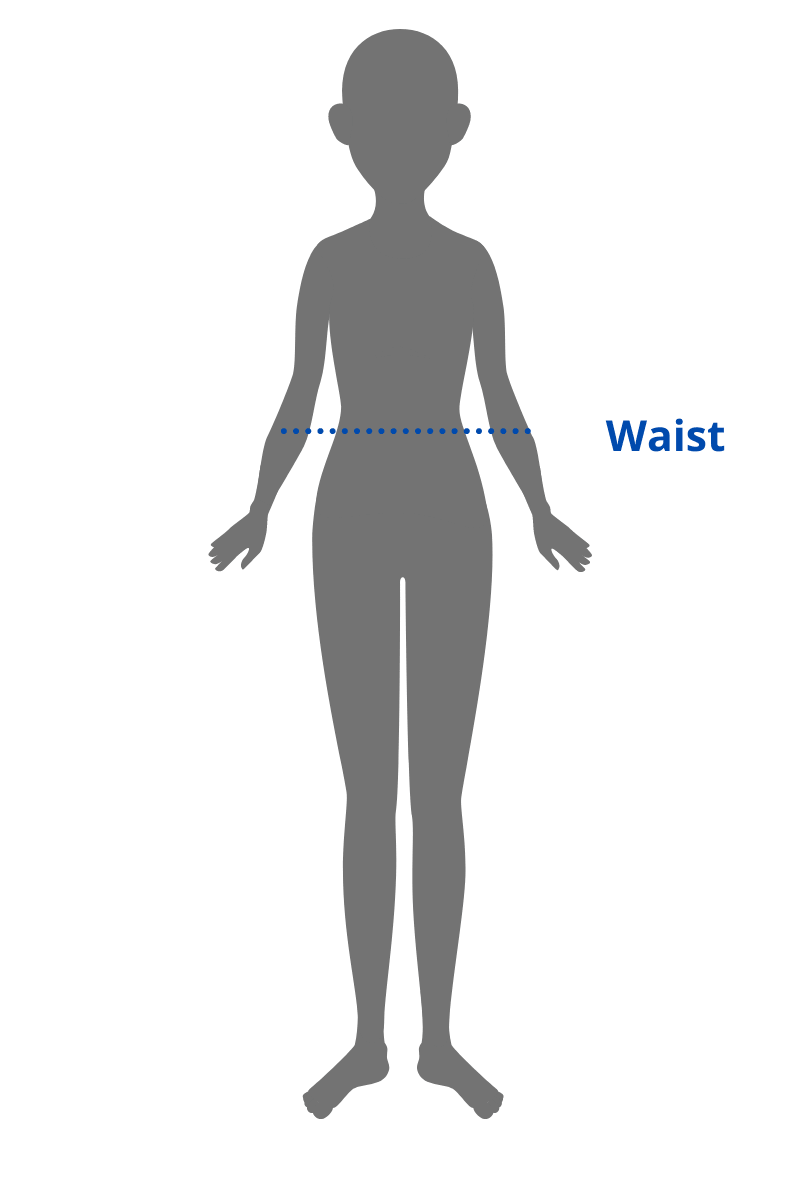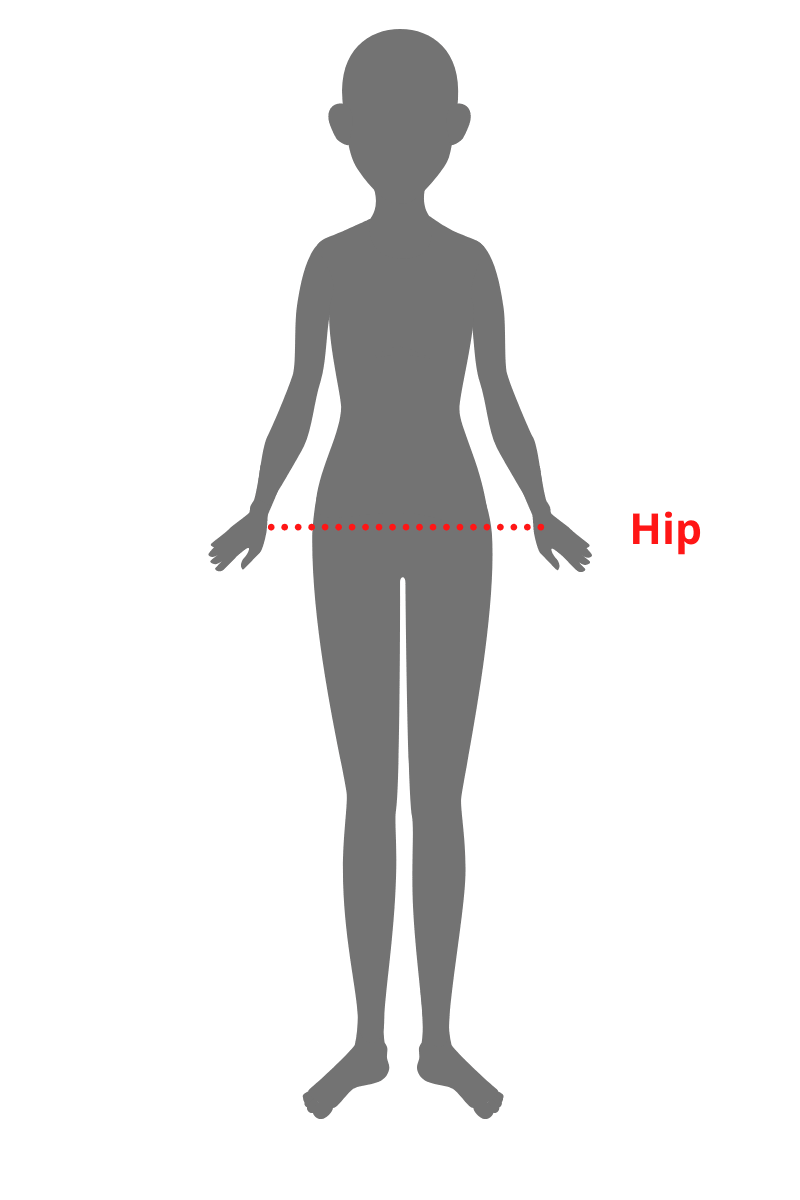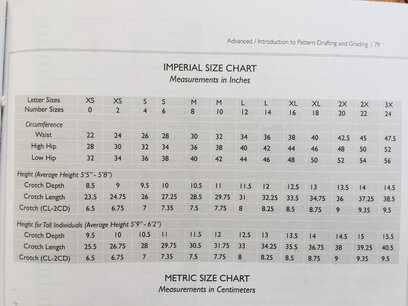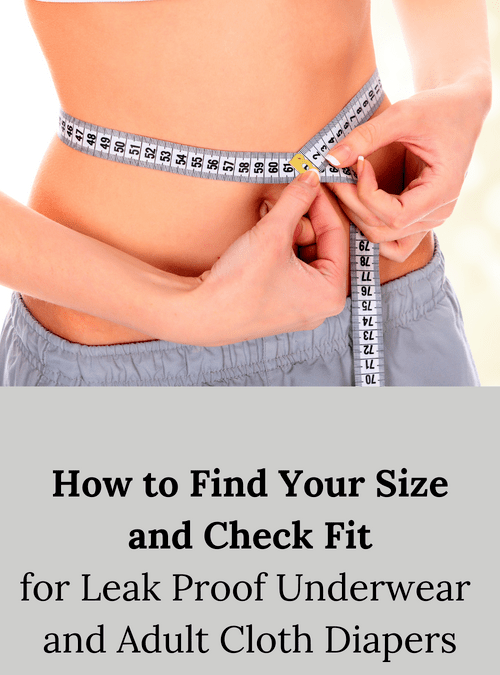It’s nice to have nice fitting things, but it’s even nicer to have nice fitting things that will totally deliver on protection and it never hurts to be nice to look at too.
But how do you make sure your nice looking leak proof underwear or cloth diaper is also nice fitting so you can have comfort and protection?
Personally, nothing derails me faster when buying things online than being uncertain if something will fit. Especially if that said something has no returns.
Since incontinence products fall under the, uh, hygiene items of sensitive nature, many companies don’t allow for returns. Which is fair in my opinion because, well, companies probably don’t want to deal with the return of used items.
I mean, I used to manage a drop-in center for homeless women in Los Angeles and people would donate all sorts of things, including used and unwashed underwear. And it wasn’t a one-time thing either.
So a note to the wise; if you’re going to donate stuff (kudos to you for helping others AND keeping stuff out of the landfill!) please make sure everything is clean first. If you don’t want to wash it, just toss it out because the facility you’re donating to probably doesn’t have the ability to wash it and will just throw it out.
Anyway.
For this article, we’re going to focus on fit and how to find your measurements so when you do purchase an item online, you can feel assured that the item will fit. A good fit is essential to both your comfort and to preventing leaks.
If you’re concerned with how an item fits and works, give the comments section a brief perusal for other peoples’ thoughts. They will mention if an item runs small or large.
Speax has the awesomest comments section when it comes to these things, just so ya know.
ALSO, Price should not be the only consideration you have when purchasing a product.

:I know, I know, saving money is a huge reason why many people switch to cloth, but I’m going to impart some wisdom, from one cheapo to another.
I’ve learned that it’s better to pay more for EXACTLY WHAT you want than to go for the cheapest item that’s kinda what you want.
Not only will you feel happier about your purchase, you won’t find yourself discarding the cheaper item and paying for yet another cheaper item and on and on until you have a drawer full of items that you don’t really like. Not to mention all the money you spent on them….
Just channel Marie Kondo and go with the whole sparking joy thing 🙂
Here’s how to find the right size of adult cloth diapers:
How to take your measurements
The first step to figuring out what size you need is to know your own measurements.
These are the 2 most common measurements when it comes to incontinence underwear and cloth diapers:
1. Waist
2. Hip
To properly take your measurements, get a flexible measuring tape that can easily wrap around the body. If you don’t have a flexible measuring tape, find a piece of string. You can wrap the string around your body, marking where the ends meet and then lay the string against a yardstick or tape measure.
Keep the measuring tape or string parallel to the ground and hold it snugly, but not tight. This is key for correctly measuring adult size diapers.
Waist
In the garment industry, the waist measurement refers to your body’s natural waist, regardless of where the garment actually sits on your body.
For example, if a man wears a size 34 pant, then that doesn’t mean his hip measurement where the pants sits is 34”. His waist is 34”, his hip measurement would actually be larger.
If they were the same, then I could actually wear my husband’s jeans. He’s got these super soft patched jeans that are totally hippie/grunge and I just know they’d be my new favorite pants. But alas, they’re too big even though my hip measurement is 35” and they’re size 34.

To find your waist measurement:
Step 1: Feel for the bottom of your rib cage. This marks the narrowest part of your torso, usually right above your belly button.
Step 2: Using your tape measure or a bit of string, find the circumference of that part of your body.

Hip
The hip measurement refers to the widest part of your hips.
The hip measurement is important particularly if you are looking at a pull on product that does not have any closures. The waist of a pull-on product must stretch enough to accommodate the width of the lower hip, otherwise you will have a really hard time getting the product on. This is essential especially if the incontinence item is a cover that needs to go over an even bulkier diaper.
To find your hip measurement:
Step 1: Stand with your feet together
Step 2: Take measuring tape or string and wrap it around the widest part of your hips.
How to Find Your Size on an Adult Diaper Size Chart
Does anyone else find size charts confusing?
Standard size charts use an average measurement of human bodies for waist, hip, rise, etc. Your measurements may not fit exactly into one company’s size chart and that’s okay.
But if you know your measurements, size charts don’t have to be confusing. Again, if you’re concerned about fit, just check the comments to make sure the item doesn’t run small or large.
Here is an example of the size chart, also known as a sizing guide, that I use to create the proportions of my incontinence item patterns.
As you can see, it’s all so mathematical!

Most places use a similar imperial size chart, but how they interpret that size chart for their product proportions varies. This is why one company’s products may run small or another large despite the fact that they list the same numbers in their size chart.
For example, the following chart shows the differences in size LARGE between different company sizing charts:
| US Size | Waist | Low Waist (directly above buttocks) | Hip | |
| Company A | 32.5”- 34” | 41” – 43” | ||
| Company B | 12/14 | 31”- 34” | 41”- 44” | |
| Company C | 12/14 | 30” – 33” | ||
| Company D | 8/10 | 26” – 27” | 38” – 40” |
Notice that Company C & D – while size Large – have smaller measurements. This is fairly common with products manufactured in China with companies who drop ship or otherwise have minimal involvement in the creation process – especially if you’re shopping on Amazon.
Just size up or find another product.
In addition, since many cloth incontinence products are stretchy, some companies helpfully offer a range of sizes that their item may fit, like 24”-34.”
Tips for Finding Your Size
- 1. Unless an item is high-waisted and meant to go around your actual waist, pay more attention to the hip measurement.
For example, if your waist is 36,” but your hip is 43,” and the item in question will sit a few inches below your belly button, you would still be a size large.
2. If you find yourself between sizes or at the tippy top range, it’s always better to size up unless the product runs big.
How to Check Your Products’ Fit
Once you purchase your product, it’s important to check the fit. This is to ensure your incontinence product won’t leak due to ill-fit.
This is also why I ALWAYS recommend purchasing only one of a particular item first and checking the fit before buying in bulk!!!
1. Are there any gaps at the waist and leg opening?
To check this, move your leg in a circle and see if any gaps appear along the leg crease. If you are unable to adjust the leg, as in the case of a front snap closure diaper, try a smaller size or different brand.
For the waist, the product should feel snug against your body, but not so tight as to leave red marks. If you’re caregiving for someone who is lying down, you can check the fit by gently pulling out the waistband and leg band. If you have trouble pulling the band out, the product may be too tight. If it gives a lot, consider sizing down.
Remember, products work best when they fit snugly against the body but the fit shouldn’t be so tight as to be uncomfortable.
2. Does your product have inserts?
While diaper styles like pocket work by stuffing the absorbent layers – ie. inserts– into the diaper between the cover and lining, some period and incontinence underwear have the option of adding pads for additional protection.
Actually, inserts are a fantastic way to add more absorption to your incontinence item without increasing drying time. However, some inserts, particularly microfiber inserts, can be bulky. Or, you can be tempted to stuff in a ton of inserts to maximize absorption.
Unfortunately, over stuffing can cause leg gaps where there weren’t any before. To check this, rotate your leg and look to see if any of the inner product can be seen from the outside.
If any of the inside layers are poking out, then it’s a good sign that the cover is not big enough or that you have too many absorbing layers in the diaper.
If you need more absorption than your current incontinence item can offer you (some products can only handle so many layers of absorption before it affects fit) then it might be time to try something different, particularly one that is recommended for overnight use, as these offer the most absorbing abilities.
3. Is your incontinence item starting to wear out?
Nothing lasts forever, and this applies to leak proof underwear and cloth diapers too. While there are many factors that determine how long an item will last, the truth is, they will eventually start to wear out. When this happens, leaks can become more and more frequent.
Leg elastic, in particular, is vulnerable to wear and tear. Over time and washing (especially if you use bleach or really hot temperatures), the elastic will become, well, less elastically. In other words, it can get stretched out and not hug the leg as tightly as before causing awkward leaking.
Knowing your measurements is essential to choosing the right size and only takes a few moments to find. Knowing your proper measurements will help prevent adult diapers from leaking. Buying leak proof underwear or a cloth diaper that fits well will not only protect you against leaks, but will give you a boost of confidence as you go about your day.
What are some of your favorite products?
Comment below or email me at hello@littleonioncloth.com!
Alecia
Latest posts by Alecia (see all)
- Best Adult Diaper Covers - March 7, 2024
- Best Fabrics for Making Adult Diaper Covers - February 16, 2024
- How to Use the Zigzag Stitch - May 4, 2023


